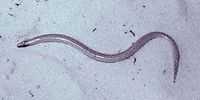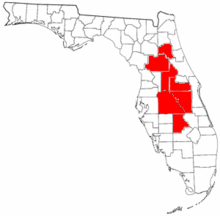Neoseps
| Sand Skink | |
|---|---|
 | |
| Conservation status | |
| Scientific classification | |
| Kingdom: | Animalia |
| Phylum: | Chordata |
| Class: | Reptilia |
| Order: | Squamata |
| Family: | Scincidae |
| Genus: | Neoseps |
| Species: | N. reynoldsi |
| Binomial name | |
| Neoseps reynoldsi Stejneger, 1910 | |
 | |
| Sand Skink range | |
| Synonyms | |
|
Eumeces reynoldsi | |
Neoseps is a monotypic genus in the lizard family Scincidae, the skinks. The sole species is Neoseps reynoldsi, commonly known as the Florida sand skink. It is endemic to Florida in the United States. The species was described by Leonhard Hess Stejneger in 1910 and named in honor of one A. G. Reynolds, who had collected the holotype.
Physical description
A unique lizard adapted to an underground existence, the sand skink measures 10 to 13 cm (4 to 5 inches) in length and is a gray to tan color. Its forelegs are tiny and bear only one toe each; its hindlegs are small and have two toes. The tail comprises about half of the animal's total length. The sand skink has a wedge-shaped head, a partially countersunk lower jaw, body grooves into which the forelegs can be folded, and small eyes which have transparent windows in the lower lids. These features enable the lizard to move through loose sand.
Biology
The diet of this species consists of surface-dwelling invertebrates, including termites, spiders, and the larvae of antlions and beetles.
Florida sand skinks are most active in spring, during their mating season. They reach sexual maturity after 1 to 2 years and remain reproductively active for two to three years. About 55 days after mating, the female lays about two eggs, which hatch in June or July.
Distribution and habitat
The Florida sand skink was classified as a threatened species by the United States Fish and Wildlife Service in 1987. It only occurs in Central Florida — 115 known sites were recorded in 1999. The species is difficult to detect and may be found elsewhere during more intensive searches. It is present on the Lake Wales Ridge, the Winter Haven Ridge in Polk County, and the Mount Dora Ridge.
The Florida sand skink lives in areas vegetated with sand pine–Florida rosemary scrub and the longleaf pine–American turkey oak association, including Florida scrub habitat. Food supply and moisture levels are important factors in the species' tolerance of habitat. Florida sand skinks are most frequently found in the ecotone between Florida rosemary scrub and palmetto-pine flatwoods where moisture is present beneath the surface litter and in the sand. The species usually remains underground and burrows 5–10 cm (2.0–3.9 in) beneath the soil to find food.
References
- Gimenez Dixon (1996). Neoseps reynoldsi. 2006. IUCN Red List of Threatened Species. IUCN 2006. www.iucnredlist.org. Retrieved on 11 May 2006. Listed as Vulnerable (VU A2ce v2.3)
- Comprehensive overview with extensive literature list.
Selected literature
- Sutton, P. E. (1996). A mark and recapture study of the Florida sand skink Neoseps reynoldsi and a comparison of sand skink sampling methods. Master’s thesis, University of South Florida; Tampa, Florida.
- Telford, S. R. (1959). A study of the sand skink, Neoseps reynoldsi. Copeia 1959 (2):100-19.
